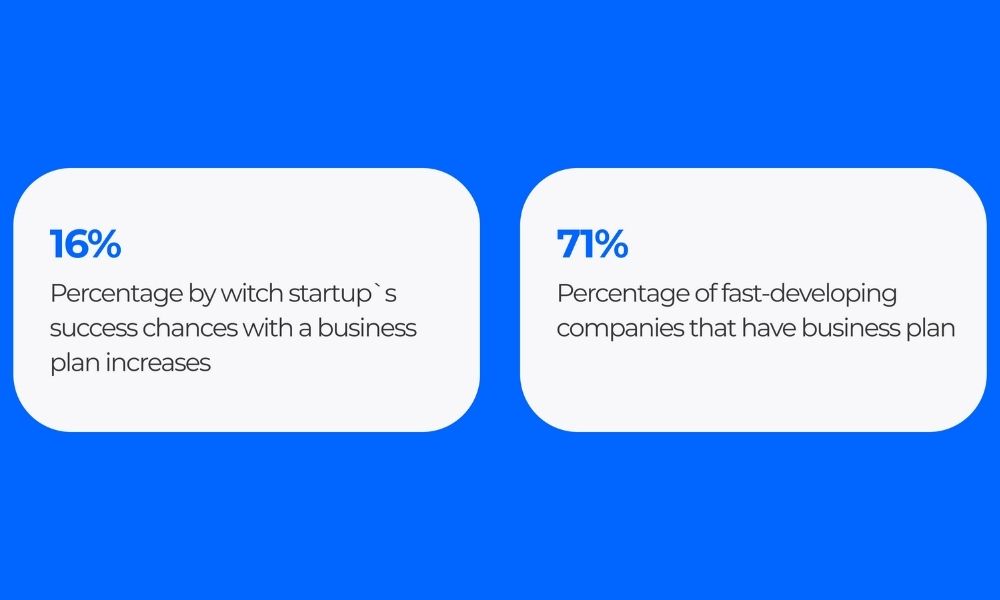Any invention starts with an idea, and startups are no exception. However, for an idea to turn into a working product that will benefit the business, you need a well-crafted plan. In the context of startups, it is a business plan, which is one of the success criteria because it increases the success of a startup by 16%. In this article, we will analyze how to write a business plan for a startup, what parts it consists of, and also provide several useful templates that will help you in the writing process. Without further ado, let’s get started.

Here’s How You Can Write a Business Plan (Template + Step-by-Step Guide):

Executive Summary
The executive summary is an introduction to your business plan that summarizes everything you describe to show the reader what your startup is about. The executive summary often consists of the following sections:
- Business overview: Here you should briefly describe your business idea and what you intend to do.
- Target market: In this section, you should tell in detail about the target market you are going to enter. Include various charts and statistics that will show the prospect of this market.
- Competition: There will often be competitors in any target market, and you should also mention them in the executive summary. Also, do not forget to talk about what you are going to oppose them.
- Finances: This section includes certain milestones that you put in front of a startup (profit, ROI, and much more)
- Team: Briefly tell us about the startup team, who are in top positions, and more.
- Funds: In the final section, you must describe how much money your project will need and what it will be spent on.
Also Read: Is Facebook or LinkedIn Better for Business?
To Write a Well-Structured and Useful Executive Summary, You Should Follow These Tips:
- Write it last: Although this section serves as an introduction, it should be written last; after all, sections are ready, and all the information you need has been gathered.
- Follow an intuitive structure: An executive summary should have a short introduction, the main body, and a summary.
- Use facts: Your executive summary should be based on proven facts. Use various statistics, charts, research results, and other information to support your words and make them more convincing for investors.
Сompany Description
It is the second section of your business plan in which you should describe your company, its structure, history, key persons, and much more in detail. To make this section as informative as possible, include the following points:
- Company history: If you are a company that has been on the market for a long time, tell your story: when the company was founded, what products you worked on before, and briefly describe them. If you are a startup mod, in this section, you can tell the story of how the startup was conceived and who was behind it.
- Location: Briefly describe where your business is located. For example, specify the location of key offices. If you are a startup, please describe in detail which location you have chosen as your office.
- Type of business: Tell us in detail about your business, namely about its specialization and what industry it belongs to.
- Legal structure and ownership: This section is extremely important for investors. You must describe in detail what kind of structure your company has: LLC, C-Corp, S-Corp, Sole proprietor, or you are in partnership.
Marketing Plan
Any product that is going to enter the market needs specific marketing goals and competitive advantages. This is what you will describe in the third section of your business plan. It is very important to include the following points in this section:
- Target audience analysis
- Competitor analysis
- SWOT analysis
You May Also Like:
Target Audience Analysis
Any market consists of buyers who are divided into audiences according to certain criteria. Businesses need to understand for whom they are making their product. That is why you must conduct a detailed analysis of your target audience.
Start with simple guesses based on the following criteria:
- Gender
- Age
- Location
- Education
- Income
- Ethnicity
This will help you get a rough idea of who your target audience is. For example, your startup aims to create a FinTech app, namely a banking app. Besides that, you want to launch it on the east coast of the United States. After a small brainstorm, your target audience will look like this:
- Males and females
- Age 16 to 70+
- Lives in Washington, DC.
- Secondary education+
- With income from $ 30,000 to $ 100,000+
- Students with scholarships, clients of banks who store savings and conduct online transactions, segments of the population that require payments from the state.
Next, you should conduct research that should support your assumptions. For example, you can conduct online surveys among your target audience in order to identify certain patterns that will help you better understand what your future customers want.
In addition, you can analyze the audience of your competitors. This will help you better understand what attracts customers to a competitor’s product (service level, special conditions, social interaction, and much more).
Competitor Analysis
To run a successful business, you need to know your competitors, strengths, and weaknesses. This will help you adapt your product to the realities of your business and give your audience a unique offer that will set you apart from the competition. To conduct a qualitative analysis, follow this algorithm.
- Find your competitors. The first step is to find your competitors. Start with simple Google searches, gradually expanding the list. Do not forget to also look for various mentions of competitors in the media and other sources.
- Examine them. Next comes the learning phase. You need to know everything about your competitors. Their products, pricing, time on the market, organic traffic, and more.
- Categorize them. Based on the data obtained, you must assign a certain category to each competitor. This will help you identify major competitors and secondary ones.
Related Articles:
SWOT Analysis
SWOT analysis stands for Strengths, Weaknesses, Opportunities, and Threats:
- Strengths: This category includes the strengths of your business that set you apart from the competition.
- Weaknesses: These are the anchors that slow down your business.
- Opportunities: These are the levers of the business that help it grow.
- Threats: These are threats that can affect business development but do not depend on them in any way.
For a more convenient and quick analysis, we recommend that you use this template.

Financial Plan
One of the most important parts of a business plan for an investor. In short, this section is dedicated to the financial projections of your business. Include the following items in this section:
- Balance sheet: This item includes the current financial position of the business and financial reserves.
- Expense projections: Investors will pay close attention to this item as it contains a plan for the future expenses of the business.
- Income projections: At this point, you will detail your forecasts for sales and future profit.
- Cash flow projections: In simple terms, this paragraph describes all the money that’ll go in and out of business.
Although we have briefly described these points, it takes a long time to complete the financial plan. To make your life easier, we recommend using this financial plan template.

Team Structure
This is the last part of your business plan to describe your company’s hierarchy in more detail. Include the following items to make this section as informative as possible:
- Management team: You should describe each key person in the business, their experiences, accomplishments, and more. Show that expert people run your startup.
- Management team gaps: In this section, you should include control positions that are currently empty. Describe in detail what candidates you are looking for.
- Board members: If your startup has a Board of Directors or the Board of Advisory, they should also be included in this section.
See Also:
- How to Plan Your SaaS Marketing Budget and Win
- Digital Marketing Tips and Tricks for Startups
- How AI will Make the Marketing Mix More Personalized?
Conclusion
Writing a business plan is a rather laborious and long process, but every startup goes through it. After all, without a clear plan, a great idea runs the risk of remaining an idea. Finally, we want to make you a small gift. To make it easier for you to write a business plan, we have prepared a complete template that fully corresponds to all the points that we have described in this article.
Vitaly Kuprenko is a technical writer at Cleveroad, a web and mobile app development company in Ukraine. He enjoys writing about tech innovations and digital ways to boost businesses.





















